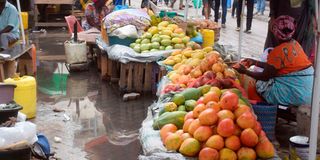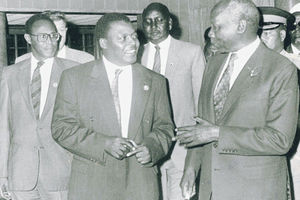Premium
It stinks! Shame of raw sewage in Mombasa streets
What you need to know:
- The County Executive in charge of Water, Environment, and Climate Change, Ms Emily Achieng' attributed the poor sewerage system to an old infrastructure built during the colonial era to serve a much smaller population.
- “As a county, we have put in measures and plans to break down the sanitation value chain to make Mombasa City clean,” she said.
For a city that prides itself as a coastal tourist destination, black, raw sewage would be the last thing a visitor would expect to come face to face with in Mombasa.
However, this is what residents and guests who would rather enjoy the blue ocean waters are subjected to in some places, including within the Central Business District (CBD).
Now and then, the sewage system blocks and its toxic content overflows into the streets.

Construction works along Digo Road in Mombasa County on January 14, 2025. The residents say the county stinks from pockets of sewerage overflows in the CBD and various estates, calling for a speedy permanent solution.
For the past two months, for instance, Mombasa residents and tourists have been treated to a foul smell emanating from the collapsed sewage system within the CBD.
The worst-hit area is the famous Markiti Market, where raw sewage flows within business sections. Customers and traders have to jump over pools of raw sewage.
A similar situation is evident at the Mtopanga Estate, a residential area where residents are worried about the eruption of waterborne diseases.
Monica Mwero, a resident of Mtopanga, says her children have been suffering from Diarrhoea due to the sewage.
“My house is just near the sewer and my children play around, we can’t sleep at night because of the stench," she said.
The drainage and garbage menace in Mombasa have been a headache in the port city for decades. Residents have been living with sewage stench and stale garbage.
Mahmoud Abdallah, a village elder in Markiti market, says Mombasa has turned into a filthy and smelly city, and this poses a threat to the tourism sector.

Traders sell their items over sewer flow at Marikiti Market in Mombasa CBD on January 14, 2025. The traders are calling for a speedy and permanent solution to the drainage menace in the County.
“Mombasa was full of life with a beautiful scent coming from ancient flowers, but almost everywhere you go now, the air is polluted by the strong smell from sewage systems,” he said.
According to Fatuma Karisa, who sells fish beside sewage water, the sewage discharge demonstrates a blatant disregard for public health and environmental safety.
“The odour emanating from the polluted waters has made me lose clients, and the heightened risk of contracting waterborne diseases has further exacerbated the situation,” she said.
Frustrated residents are now demanding lasting intervention.
Often, the county government administration steps in to unclog the drainage system but this usually only lasts for a short while.
The situation even worsens during the rainy season when the filth of recklessly disposed garbage and overflowing raw sewage mixes up with rainwater flooding the streets.
“They have been coming to unclog the drainage systems but that is not a solution, the problems keep on resurfacing," says Simon Mwangi, a Mombasa resident.

Mombasa county, CEC for Water Emily Achieng, during in an interview on January 14, 2025.
Regarding the situation at the CBD, Mombasa County Chief Officer for Transport and Infrastructure Albert Keno said the county team investigated and realised there was a big blockage around Konza Mosque.
He acknowledged that there was a big problem with the sewer system within the city but assured that ongoing construction to repair the pipes would offer a lasting solution.
"We called the water service provider (Mombasa Water and Sewerage Company) Mowasco, alongside the technical team to repair. It was a big pipe going 28 feet down, that's why we took some time," he said.
The County Executive in charge of Water, Environment, and Climate Change, Ms Emily Achieng' attributed the poor sewerage system to an old infrastructure built during the colonial era to serve a much smaller population.
“As a county, we have put in measures and plans to break down the sanitation value chain to make Mombasa City clean,” she said.
Residents, especially those in the Markiti market have been urged to avoid blocking the sewer system.





